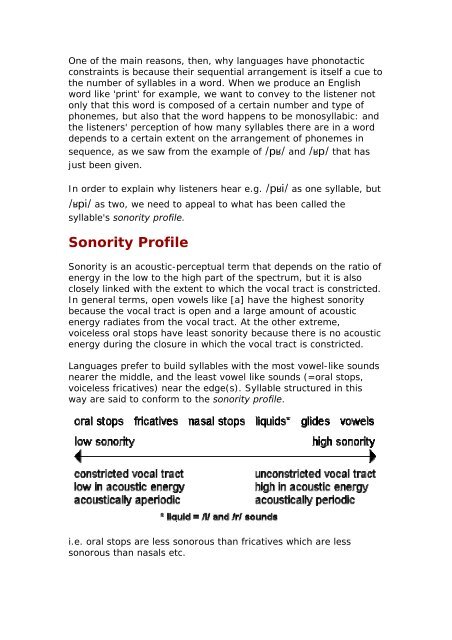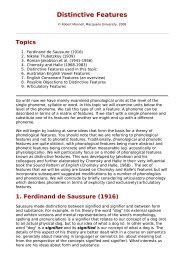The Syllable and the Foot : Summary - Speech Resource Pages
The Syllable and the Foot : Summary - Speech Resource Pages
The Syllable and the Foot : Summary - Speech Resource Pages
Create successful ePaper yourself
Turn your PDF publications into a flip-book with our unique Google optimized e-Paper software.
One of <strong>the</strong> main reasons, <strong>the</strong>n, why languages have phonotactic<br />
constraints is because <strong>the</strong>ir sequential arrangement is itself a cue to<br />
<strong>the</strong> number of syllables in a word. When we produce an English<br />
word like 'print' for example, we want to convey to <strong>the</strong> listener not<br />
only that this word is composed of a certain number <strong>and</strong> type of<br />
phonemes, but also that <strong>the</strong> word happens to be monosyllabic: <strong>and</strong><br />
<strong>the</strong> listeners' perception of how many syllables <strong>the</strong>re are in a word<br />
depends to a certain extent on <strong>the</strong> arrangement of phonemes in<br />
sequence, as we saw from <strong>the</strong> example of /pʁ/ <strong>and</strong> /ʁp/ that has<br />
just been given.<br />
In order to explain why listeners hear e.g. /pʁi/ as one syllable, but<br />
/ʁpi/ as two, we need to appeal to what has been called <strong>the</strong><br />
syllable's sonority profile.<br />
Sonority Profile<br />
Sonority is an acoustic-perceptual term that depends on <strong>the</strong> ratio of<br />
energy in <strong>the</strong> low to <strong>the</strong> high part of <strong>the</strong> spectrum, but it is also<br />
closely linked with <strong>the</strong> extent to which <strong>the</strong> vocal tract is constricted.<br />
In general terms, open vowels like [a] have <strong>the</strong> highest sonority<br />
because <strong>the</strong> vocal tract is open <strong>and</strong> a large amount of acoustic<br />
energy radiates from <strong>the</strong> vocal tract. At <strong>the</strong> o<strong>the</strong>r extreme,<br />
voiceless oral stops have least sonority because <strong>the</strong>re is no acoustic<br />
energy during <strong>the</strong> closure in which <strong>the</strong> vocal tract is constricted.<br />
Languages prefer to build syllables with <strong>the</strong> most vowel-like sounds<br />
nearer <strong>the</strong> middle, <strong>and</strong> <strong>the</strong> least vowel like sounds (=oral stops,<br />
voiceless fricatives) near <strong>the</strong> edge(s). <strong>Syllable</strong> structured in this<br />
way are said to conform to <strong>the</strong> sonority profile.<br />
i.e. oral stops are less sonorous than fricatives which are less<br />
sonorous than nasals etc.
















